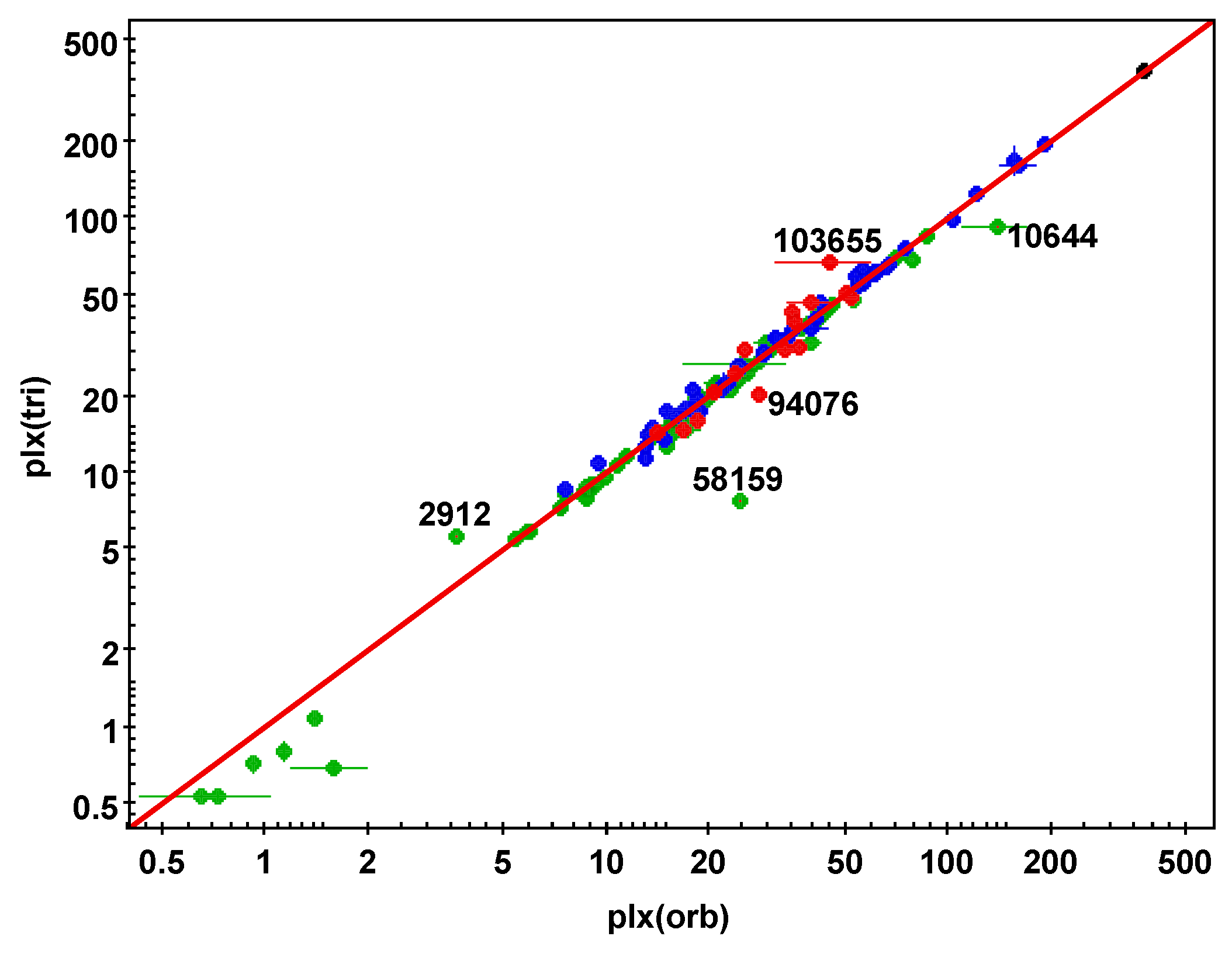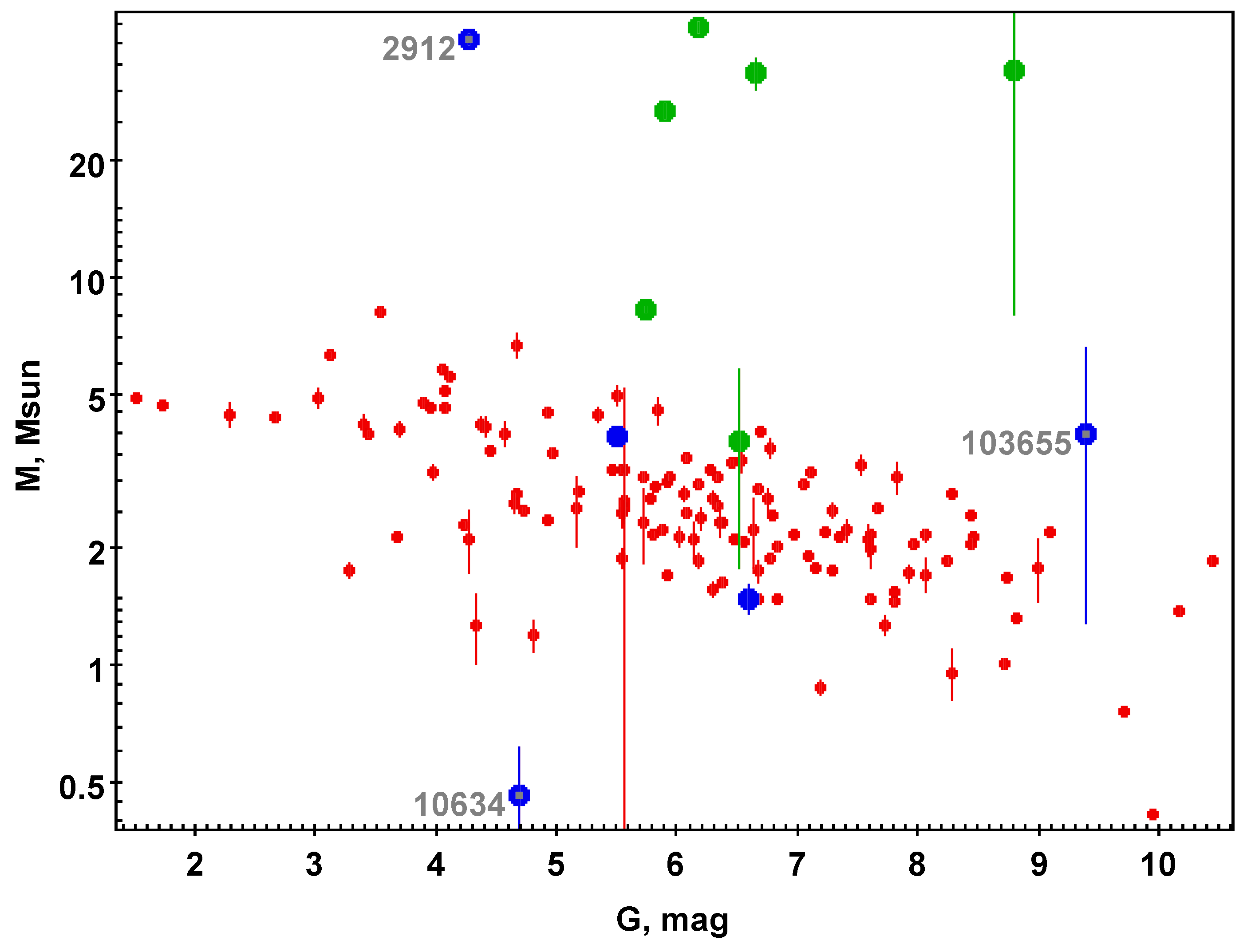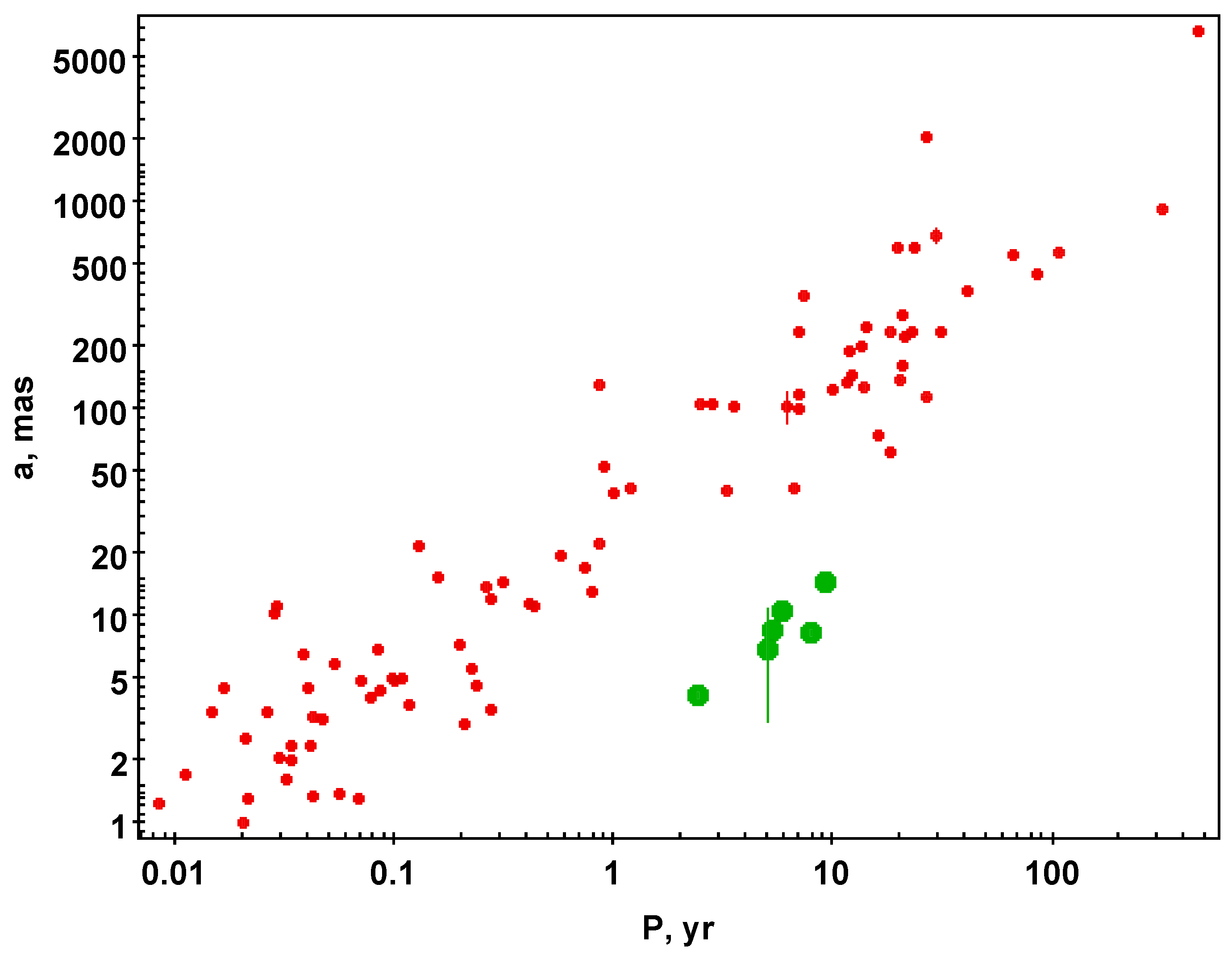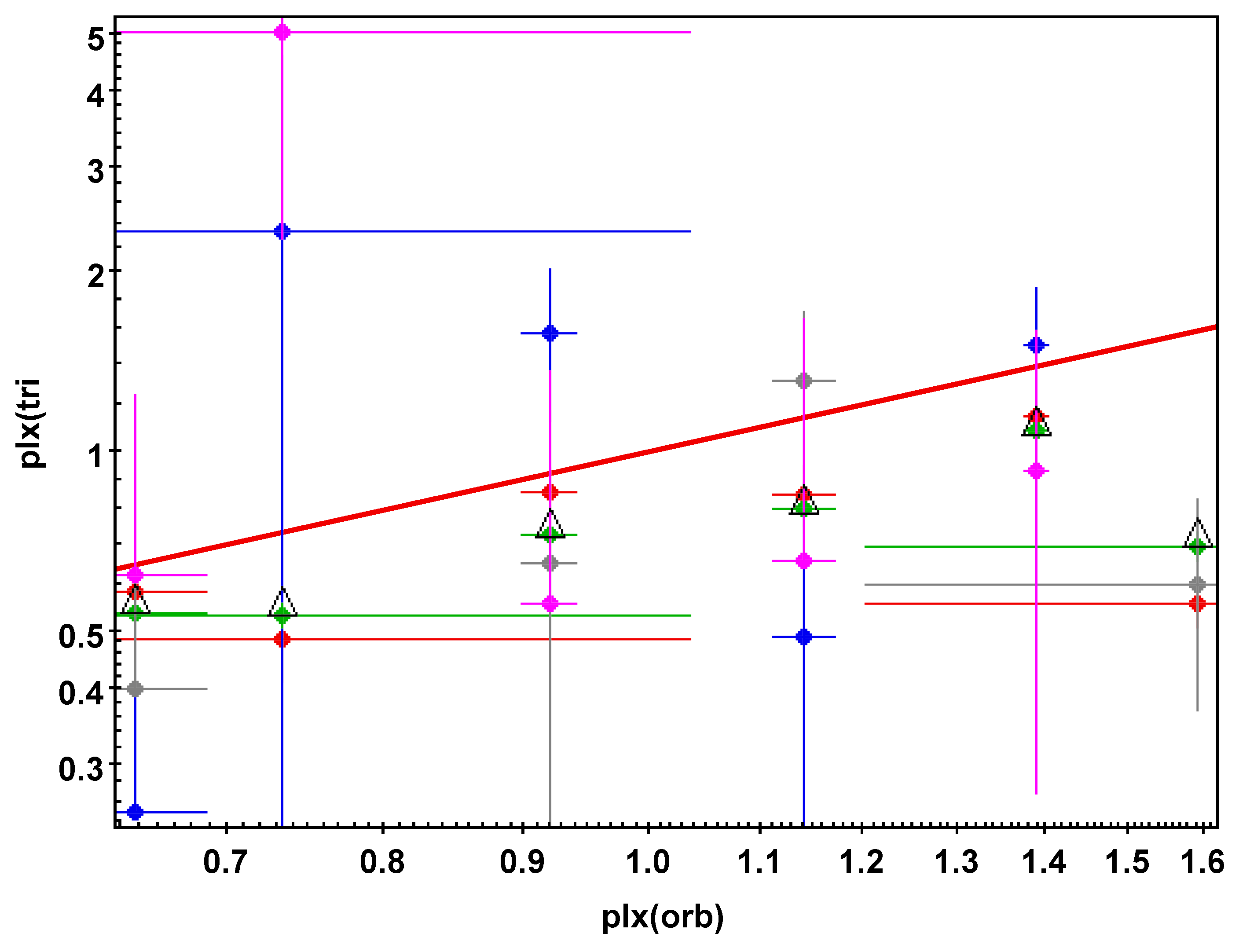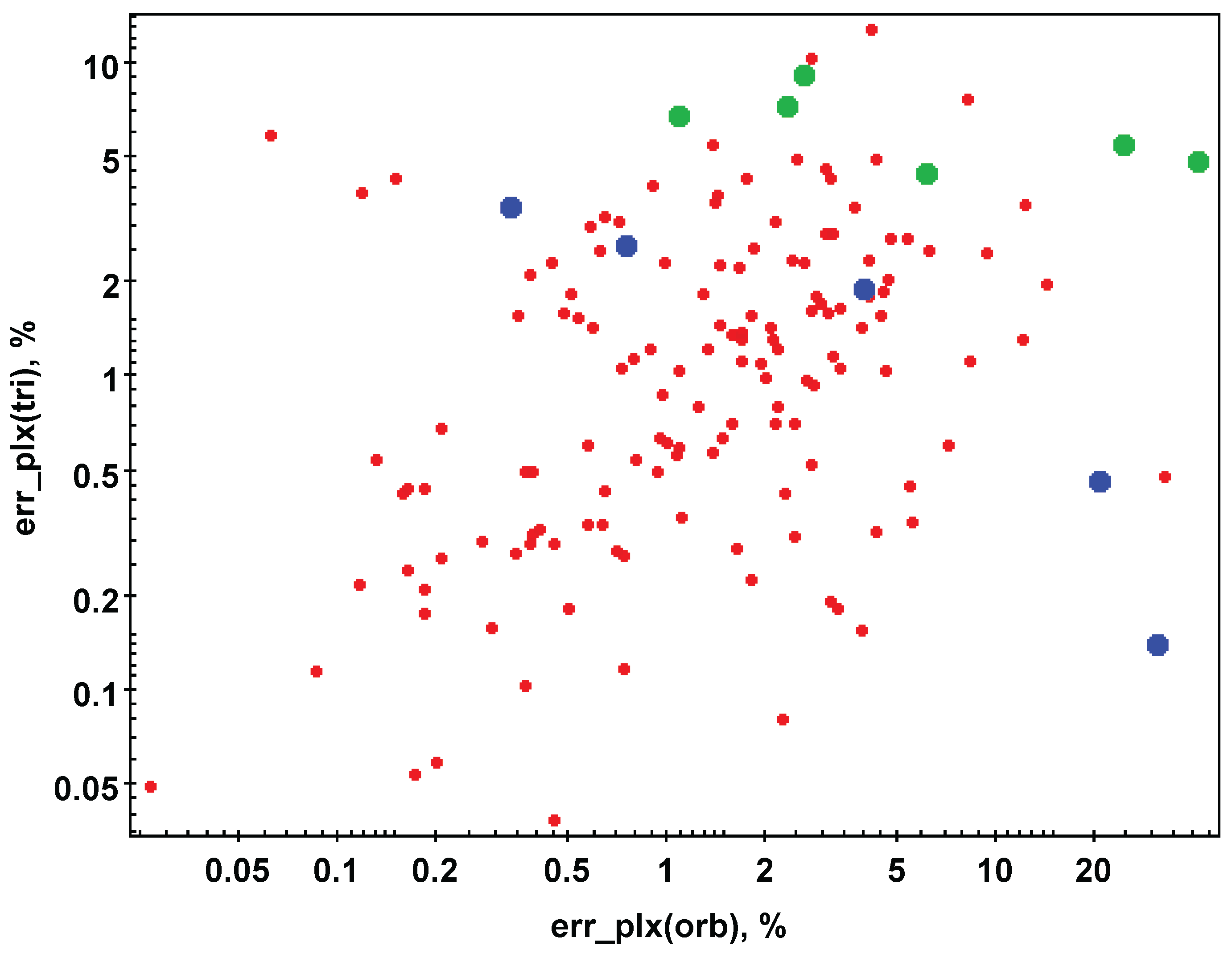1. Introduction
Determining the distance to celestial objects is one of the most important and difficult problems in astronomy. Many methods have been devised to solve this problem: trigonometric parallaxes, assumptions about the absolute stellar magnitude of an object (the so-called photometric distance; this method is applicable to both Galactic stars and extragalactic objects like SN Ia supernovae), period-luminosity relations for some types of variable stars, HRD for clusters, redshift for galaxies, and others. All these methods allow us to estimate the distance to a large number of objects: from hundreds of thousands to billions (Gaia). However, all these methods, except the first one, require certain assumptions about the nature of the object and the characteristics of the media between the object and the observer (primarily the properties of the gas–dust component). In this paper, we discuss objects whose distance can be determined from dynamic considerations without making assumptions about their nature.
When a spectroscopic binary is visually resolved, the typical approach for deriving the parallax and masses consists of combining the independently obtained visual and spectroscopic orbits. Knowledge about both the visual and spectroscopic orbits in binary systems is very important for stellar astronomy as the combined analysis of astrometric and spectroscopic observations produces, without any additional assumptions, a complete 3D binary orbit, enabling precise distance, luminosity, and masses of the system components to be determined. Orbital parallax can only be determined for double-lined spectroscopic binaries with spectroscopic and visual orbits.
So, resolved spectroscopic binaries (RSB) provide us with the only method (apart from trigonometric parallax) to directly determine (rather than estimate) the distances to stars. Ref. [
1] was one of the first to draw attention to this fact and compiled a list of about 40 RSB systems.
In a recently compiled comprehensive catalogue of resolved spectroscopic binary systems [
2], we presented an analysis of 173 RSB, selected from the lists of binaries published by [
1,
3,
4,
5] and about 50 other publications, and supplied by data from external sources. We later revised our list and removed systems with very low-quality data and objects that were included by mistake. The catalog currently contains 153 RSB.
In this paper, we focus on comparing the trigonometric and orbital parallaxes of the catalogued stars (
Section 2), and discuss the reasons they do not show agreement: inaccurate or wrong orbital (
Section 3) and inaccurate or wrong trigonometric (
Section 4) parallaxes. Finally, in
Section 5, we draw our conclusions.
2. Comparison of Orbital and Trigonometric Parallaxes
Recall that the orbital parallax
can be deduced according to
where
and
a are the semimajor axes of the visual orbit expressed in seconds of arc and AU, respectively. From the data of the spectroscopic orbit, we have
, where
i is the inclination of the visual orbit. Thus, the analysis of the visual (
) and spectroscopic (
) orbits allows us to obtain a
value for RSB.
A comparison of the orbital
and trigonometric
parallaxes (the SIMBAD database was used to obtain the latter) is shown in
Figure 1. It can be seen that the data are in good agreement. For five stars,
exceeds 0.2, they are marked with their HIP numbers. Having analyzed the characteristics of these outliers (see
Section 3), we can draw preliminary conclusions about the region in the observational parameter space, where orbital parallaxes can be preferable to trigonometric parallaxes. We separately analyze the divergence in the parallaxes of the most distant (
mas) stars (see
Section 4). The distribution of RSB over orbital parallaxes is shown in
Figure 2.
3. Outliers
A number of stars in
Figure 1 show a marked difference between orbital parallaxes and trigonometric parallaxes (recall that the axes in the figure are given on a logarithmic scale). It is interesting to look at other values of trigonometric parallaxes available for these stars in the literature.
Table 1 includes parallaxes obtained for these stars by the Hipparcos mission (original version [
10] and new reduction [
6]), by the Gaia mission (DR2 [
7] and DR3 [
8] releases; none of the stars listed are found in the DR1 TGAS release [
11]). Also included in
Table 1 are the ground-based parallaxes from The General Catalogue of Trigonometric Stellar Parallaxes, Fourth Edition catalogue [
12] and the orbital parallaxes presented in this paper.
It can be seen that the parallaxes of all releases from both space missions (i) differ very little from each other, and (ii) unanimously contradict the orbital parallaxes.
HIP 103655 is one of the faintest (
mag) objects in the sample, almost all of the others are brighter than
mag. HIP 10644 and HIP 2912 are one of the least massive (
= 0.25 ± 0.15 + 0.22 ± 0.14
) and one of the most massive (
= 29.23 ± 0.93 + 11.83 ± 0.38
) systems in the sample, respectively (see
Figure 3). Obviously, the accuracy of determining the
trigonometric parallax of a star does not depend on its mass. On the contrary, the
orbital parallax of the system is determined simultaneously with the masses of the components; hence, these parameters can correlate. Thus, in these cases, the cause of the discrepancy should not be sought in the trigonometric paralax but in the orbital parallax.
These considerations suggest that the orbital parallaxes for this group of stars are not precise enough.
Let us add that [
3] also noted that the orbital parallaxes of HIP 2912, HIP 10644, HIP 94076 differ markedly from the trigonometric parallaxes, and [
1] drew attention to the divergence of the orbital parallax from the Hipparcos parallax for HIP 103655. In all cases, the authors explain this by the low quality of the visual and/or spectroscopic orbits.
The distribution of the catalogued objects by orbital period and semi-major axis is shown in
Figure 4.
Concluding this section, we can say the following. There is good agreement between the trigonometric parallaxes obtained as a result of the work of different space missions (see
Table 1) for the five studied stars. It suggests that the reason for their mismatch with the orbital parallaxes is, apparently, the inaccuracy of the latter. Other authors have also paid attention to this discrepancy. Some of these stars occupy a marginal place in terms of brightness or the mass of the components, which could also affect the quality of determining the orbital parallax. This question requires further investigation, and additional observations of these stars are required for more definite conclusions.
4. Distant Stars
The group of six low-parallax outliers (see
Figure 1) irrefutably demonstrates that the space-born parallax values of all distant (
2 mas,
0.5 kpc) orbital binaries are biased downward (i.e., the distances appear to be overestimated) due to orbital motion.
It is interesting to compare the different trigonometric parallaxes for these stars available in literature among themselves. According to The General Catalogue of Trigonometric Stellar Parallaxes, Fourth Edition [
12] there are no ground-based parallaxes for these stars, except for HD 193793, which has a parallax of
mas. Parallaxes published in different Gaia releases and different Hipparcos releases are presented in
Table 2 and
Figure 5. Unlike the outliers discussed in
Section 3, here, the values of space-born parallaxes obtained by different telescopes and published in different releases differ (sometimes quite markedly). Apparently, the presence of such differences can be considered a sufficient (but not necessary) indicator of the hidden binarity of the object. Let us note, however, that the discrepancies between Gaia DR2 and DR3 are nowhere large enough that 2.5
, and the discrepancies with TGAS and Hipparcos are probably not that useful, given the very different quality of the astrometry. It is also interesting to note that the values of
(see
Table 2) for all stars except HD 152233 (which has the largest value of the orbital parallax error) lie within fairly narrow limits: 0.70–0.83.
It makes sense to also look at some of the flags that explored stars have in space mission data releases; first of all, RUWE and ipd_frac_mul_peak parameters in Gaia (as indicators of unresolved binarity) and F2 value (goodness of fit) on Hipparcos.
Renormalised Unit Weight Error (RUWE) is associated with each source. RUWE is expected to be around 1.0 for sources where the single-star model provides a good fit to the astrometric observations. A value significantly greater than 1.0 (say, >1.4) could indicate that the source is non-single or otherwise problematic for the astrometric solution see also discussion in [
13], Section 4.2.4.
ipd_frac_multi_peak (IPDfmp) is a percent of successful-IPD windows with more than one peak. This field provides information on the raw windows used for the astrometric processing of this source coming from the Image Parameters Determination (IPD) module in the core processing. It provides the fraction of windows (having a successful IPD result), as percentage (from 0 to 100), for which the IPD algorithm has identified a double peak, meaning that the detection may be a visually resolved double star (either just visual double or real binary). It should be noted, however, that if these RSBs are indeed all unresolved for Gaia, the ipd_frac_multi_peak field is not expected to be informative. Only for sources with angular separations above 0.2–0.3 arcseconds does this data quality indicator provide useful information on binarity.
F2, the goodness-of-fit statistic, indicates the goodness-of-fit of the astrometric solution to the accepted data (i.e., excluding the percentage of rejected data). For good fits, F2 should approximately follow a normal distribution with zero mean value and unit standard deviation. F2 values exceeding, say, 3, thus indicate a bad fit to the data.
RUWE,
ipd_frac_mul_peak, and F2 values for the studied stars are presented in
Table 2. It can be seen that (except for the RUWE value for HD 203156) they appear powerless to detect the binarity of distant RSBs, ref. [
14] suggest a limit of RUWE = 1.25, but most of the objects in
Table 2 are also below this limit.
Student’s t-test statistics for Gaia DR3 and orbital parallax are also presented in
Table 2. It can be seen that for all but HD 168137, the reliability of the difference in mean values can be considered proven.
In [
15], a comparison was created between the trigonometric parallaxes of VLBI and Gaia DR3 for 126 radio stars. Based on their differences, an estimate of the systematic offset between the optical and radio reference frames was obtained, which can be expressed in mas units as
However, as can be seen in
Figure 5, this correction cannot explain the discrepancy found between the orbital and trigonometric parallaxes.
In their recent study of Gaia data, ref. [
14] explored how deviations from single object astrometry allowed the observer to infer the presence of an unresolved binary companion. They generated a catalogue of simulated binary systems and examined synthetic observations matching Gaia survey’s scanning law and astrometric data processing routine. They showed how the unit weight error and proper motion anomaly varied as a function of period, as well as the properties of the binary. Ref. [
14] limited their analysis to nearby systems, within 100 pc, and our distant objects had distances exceeding 500 pc. Perhaps this is why (and also because of the paucity of our data) we failed to find any dependence of the orbital/triginimetric parallax discrepancy on the object’s orbital period, brightness, angular semi-major axis, or the parallax itself.
Concluding this section, we can say the following. In contrast with the conclusions at the end of the previous section, for these six stars, the cause of the mismatch of trigonometric and orbital parallaxes is the former. This is evidenced by the discrepancy between the trigonometric parallaxes obtained in different space experiments (see
Table 2). We suggest using this discrepancy as an indicator of a possible hidden binarity of the object, especially as the indicators designed for this purpose (RUWE,
ipd_frac_mul_peak, F2), as a rule, do not cope with this task. We also note that the relative errors in the trigonometric parallaxes of these objects are among the largest among catalogued stars (see
Figure 6). Apparently the use of trigonometric parallaxes with high uncertainties is somewhat unhelpful.
5. Conclusions
We can draw the following conclusions.
Resolved spectroscopic binaries (RSB) are a powerful (and probably the only) tool for checking trigonometric parallaxes. A comparison of orbital parallaxes, presented in this paper, with parallaxes published in Gaia DR3 [
8] for distant (
0.5 kpc) stars shows that in all cases, the latter ones are overestimated by 10–50%. The assumption that it is the
trigonometric parallaxes that are incorrect is based on the fact that the values of space-born parallaxes in different releases differ markedly from each other. The orbital motion, which helps determine the orbital parallax, is also a hindrance for the determination of the trigonometric parallax, since the orbital displacement can be confused with the parallactic displacement. Systems not resolved or barely resolved by the instrument determining the parallax will lead to uncertain parallaxes due to orbital motion, which is added to the parallactic motion and proper motion. Obviously, orbital motion makes quantitatively different contributions to the analysis of the data published in the first, second, and third Gaia releases (based on observations collected during the first 14, 22, and 34 months of Gaia’s routine operational phase, respectively) and in two versions of the Hipparcos catalogue (41 months). We propose interpreting such a difference as an indicator of hidden binarity and the detection of new binary stars in the Gaia/Hipparcos data.
On the other hand, analyses of five other outliers showing the difference between orbital and trigonometric parallaxes show that it is the orbital parallaxes that are incorrectly determined for them. The reasons for this conclusion are as follows: (i) for some of them, the trigonometric parallax exceeds the orbital parallax, while for others, vice versa; (ii) all space-based parallaxes for these stars show unanimous agreement (in contrast to the stars discussed in the previous paragraph); (iii) at least parts of these outliers have rather marginal brightness values ( mag for HIP 103655) or component masses ( = 0.25 ± 0.15 + 0.22 ± 0.14 for HIP 10644 and = 29.23 ± 0.93 + 11.83 ± 0.38 for HIP 2912), and the latter circumstance may affect the accuracy of the orbital parallaxes. All these stars require further investigation.
It is necessary to add that the main cause of the discrepancy between orbital and trigonometric parallaxes is that the orbits are not definitive. Some spectroscopic orbits need to be revised with new radial velocity measurements, as these are often missing in strategic locations within the orbit. The same can be said for visual orbits. So, we encourage observers to collect current observational data that would allow the orbits to be properly completed with maximum precision.
In this paper, we analyzed mainly data published before 2024. Since then, new data on orbital binaries have appeared (see, for example, compilations [
16,
17]). We will certainly use this information in our future work.
